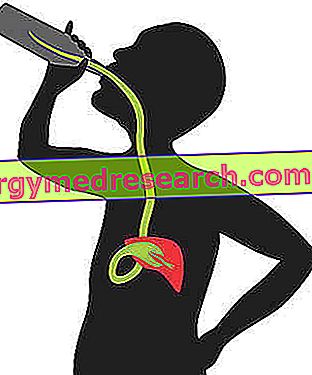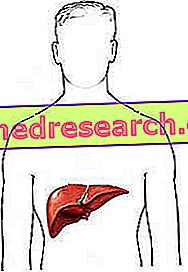Generality
Liver steatosis, known to most as fatty liver, is the most common and widespread alcoholic liver disease. This is a completely reversible condition that results in an accumulation of triglycerides in the liver . As a result, there is an increase in organ volume (hepatomegaly), which can give small signs of suffering from functional overload:
- diffuse pain in the upper right abdominal quadrant (liver tenderness),
- nausea and slight elevation of transaminases in the blood.
- More rarely alcoholic steatosis is associated with signs of cholestasis up to the full-blown jaundice.

Causes and Subjects at Risk
Alcoholic steatosis is recorded in 60-100% of heavy drinkers, while the so-called non-alcoholic steatosis is mainly the prerogative of overweight or obese people, who follow a disorderly, high-calorie and high-fat diet. Naturally the sum of the two conditions - heavy consumption of alcohol, obesity and high-calorie / hyperlipidic diet - increases stress for the liver, which at first expresses its discomfort with an accumulation of triglycerides in its cells.
Why does alcohol consumption cause steatosis?
- facilitates intestinal absorption of chylomicrons;
- increases peripheral lipolysis, with an increase in the amount of fatty acids reaching the liver;
- it depresses the oxidation of fatty acids at the level of hepatocyte mitochondria;
- stimulates the synthesis of fatty acids in the liver;
As said - despite the name can mislead - alcoholic steatosis is not necessarily synonymous with alcoholism: the two conditions, in fact, can coexist but also express themselves individually. There are therefore alcoholics with an almost normal liver, especially in the early stages, and occasional heavy drinkers who are not yet "alcohol slaves" with hepatic steatosis of alcoholic origin. The diagnosis of alcoholism is generally made through the interview with family members (the alcoholic often tends to deny his / her condition), the medical history and the compilation - by the person concerned - of questionnaires, such as CAGE, AUDIT (can be performed online on this page) o MALT, possibly supported by specific laboratory analyzes: Gamma-Glutamyl Transpeptidase (GGT) dosage, medium globular volume (VGM or MCV) and carbohydrate-deficient transferrin (CDT).
Complications
In a more advanced stage, if left untreated, alcoholic steatosis can slowly evolve to alcoholic hepatitis, more correctly defined as alcoholic steatohepatitis. In similar circumstances, the accumulation of triglycerides in the liver is associated with inflammation of the organ, which in turn can evolve or be associated with more or less extensive scarring (fibrosis to liver cirrhosis).
About 10-15% of alcoholics have typical signs of cirrhosis on autopsy. Therefore, while steatosis is a clear consequence of excessive ethanol intake, alcoholic hepatitis and cirrhosis develop in a more limited number of subjects.
Risk factors
How many grams of alcohol do you take with a drink?
The hepatopathies described in the article are the typical consequence of alcohol abuse, since the liver is the main organ involved in the metabolism of alcohol. Unfortunately, due to the heterogeneity of clinical manifestations, it is not possible to define the alcohol consumption threshold beyond which there is the risk of developing steatosis and alcoholic liver disease in general. As a general fact, the dose currently considered toxic for most individuals is more than 40-80 g of alcohol per day, although - it is good to reiterate - due to individual inter-viability it is difficult to predict the consequences of alcohol on one's own body. It should also be noted that the protracted daily consumption is more harmful than the occasional one, so much so that it is recommended not to drink alcohol for at least two days a week. Finally, the risk of alcoholic steatosis and other liver diseases is - for the same amount of alcohol consumed - greater for women, so much so that for women it is considered toxic alcoholic doses 30% lower than those indicated for men.
Alcoholic steatosis treatment
As anticipated, alcoholic steatosis is reversible, even in severe forms, within a couple of weeks after the interruption of alcohol abuse. In fact, as logic wants it to be, alcohol withdrawal is the most important and essential of therapeutic measures. Important is also the general dietetic intervention, with the adoption of a diet enriched with "lean" proteins and vitamins (especially those of group B, besides C and K) according to medical indications.
Continue: Drugs for the Treatment of Alcohol Steatosis »




